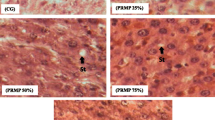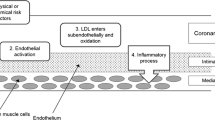Abstract
Background
Lupin protein had hypocholesterolemic effects in laboratory animals. However, the effect in humans has not been elucidated till now.
Aim of the study
To investigate the effect of lupin protein on circulating cholesterol in plasma and lipoproteins of hypercholesterolemic subjects.
Subjects and methods
A randomised, double-blind, placebo-controlled, parallel trial (23 females and 20 males completed the trial) was conducted to compare the effects of lupin protein versus casein as control protein on plasma lipids and amino acids. Thirty-five grams of the test protein were consumed daily for 6 weeks.
Results
Both lupin protein and casein resulted in a reduction of circulating plasma cholesterol (−0.50 ± 0.64 and −0.47 ± 0.79 mM; P < 0.05) from baseline to week 6. The reduction of plasma cholesterol was mainly caused by a reduction of LDL cholesterol in the lupin protein group (−0.31 ± 0.46 mM; P < 0.05), while in the casein group HDL cholesterol significantly declined (−0.17 ± 0.15 mM; P < 0.05). Comparing the lupin protein group with the casein group yielded a difference in the net changes from baseline to week 6 in the LDL:HDL cholesterol-ratio of −0.24 (95% CI: −0.007, −0.479; P < 0.05). No significant differences in net changes were observed for plasma concentrations of triglycerides, glucose, homocysteine, taurine and most of the amino acids.
Conclusions
Lupin protein compared to casein slightly lowered the concentration of LDL cholesterol in hypercholesterolemic subjects, without altering HDL cholesterol. No or minor effects of lupin protein were observed on circulating glucose, homocysteine and plasma amino acids.

Similar content being viewed by others
References
Anderson JW, Johnstone BM, Cook-Newell ME (1995) Meta-analysis of the effects of soybean protein intake on serum lipids. N Engl J Med 333:276–282
Bettzieche A, Brandsch C, Weisse K, Hirche F, Eder K, Stangl GI (2008) Lupin protein influences the expression of hepatic genes involved in fatty acid synthesis and triacylglycerol hydrolysis of adult rats. Br J Nutr 99:952–962
Cho SJ, Juillerat MA, Lee CH (2008) Identification of LDL-receptor transcription stimulating peptides from soybean hydrolysate in human hepatocytes. J Agric Food Chem 56:4372–4376
Food and Drug Administration (1999) Food labeling, health claims, soy protein, and coronary heart disease. Fed Regist 57:699–733
Horton JD, Goldstein JL, Brown MS (2002) SREBPs: activators of the complete program of cholesterol and fatty acid synthesis in the liver. J Clin Invest 109:1125–1131
Katagiri Y, Ibrahim RK, Tahara S (2000) HPLC analysis of white lupin isoflavonoids. Biosci Biotechnol Biochem 64:1118–1125
Koba K, Liu JW, Bobik E Jr, Mills DE, Sugano M, Huang YS (2003) Effect of phytate in soy protein on the serum and liver cholesterol levels and liver fatty acid profile in rats. Biosci Biotechnol Biochem 67:15–22
Lichtenstein AH, Jalbert SM, Adlercreutz H, Goldin BR, Rasmussen H, Schaefer EJ, Ausman LM (2002) Lipoprotein response to diets high in soy or animal protein with and without isoflavones in moderately hypercholesterolemic subjects. Arterioscler Thromb Vasc Biol 22:1852–1858
Martins JM, Riottot M, de Abreu MC, Viegas-Crespo AM, Lança MJ, Almeida JA, Freire JB, Bento OP (2005) Cholesterol-lowering effects of dietary blue lupin (Lupinus angustifolius L.) in intact and ileorectal anastomosed pigs. J Lipid Res 46:1539–1547
Nagata C, Shimizu H, Takami R, Hayashi M, Takeda N, Yasuda K (2003) Soy product intake is inversely associated with serum homocysteine level in premenopausal Japanese women. J Nutr 133:797–800
Petterson DS (1998) Composition and food uses of lupins. In: Gladstones JS, Atkins CA, Hamblin J (eds) Lupins as crop plants: biology, production and utilization. CAB International, Wallingford, UK, pp 353–384
Pfaffl MW (2001) A new mathematical model for relative quantification in real-time RT-PCR. Nucleic Acids Res 29:e45
Schuster D, Modi MW, Lalka D, Gengo FM (1988) Reversed-phase high-performance liquid chromatographic assay to quantitate diastereomeric derivatives of metoprolol enantiomers in plasma. J Chromatogr 433:318–325
Sirtori CR, Lovati MR, Manzoni C, Castiglioni S, Duranti M, Magni C, Morandi S, D’Agostina A, Arnoldi A (2004) Proteins of white lupin seed, a naturally isoflavone-poor legume, reduce cholesterolemia in rats and increase LDL receptor activity in HepG2 cells. J Nutr 134:18–23
Sirtori CR, Lovati MR, Manzoni C, Gianazza E, Bondioli A, Staels B, Auwerx J (1998) Reduction of serum cholesterol by soybean proteins: clinical experience and potential molecular mechanisms. Nutr Metab Cardiovasc Dis 8:334–340
Spielmann J, Shukla A, Brandsch C, Hirche F, Stangl GI, Eder K (2007) Dietary lupin protein lowers triglyceride concentrations in liver and plasma in rats by reducing hepatic gene expression of sterol regulatory element-binding protein-1c. Ann Nutr Metab 51:387–392
Teede HJ, Dalais FS, Kotsopoulos D, Liang YL, Davis S, McGrath BP (2001) Dietary soy has both beneficial and potentially adverse cardiovascular effects: a placebo-controlled study in men and postmenopausal women. J Clin Endocrinol Metab 86:3053–3060
Tonstad S, Smerud K, Høie L (2002) A comparison of the effects of 2 doses of soy protein or casein on serum lipids, serum lipoproteins, and plasma total homocysteine in hypercholesterolemic subjects. Am J Clin Nutr 76:78–84
Tovar AR, Murguía F, Cruz C, Hernández-Pando R, Aguilar-Salinas CA, Pedraza-Chaverri J, Correa-Rotter R, Torres N (2002) A soy protein diet alters hepatic lipid metabolism gene expression and reduces serum lipids and renal fibrogenic cytokines in rats with chronic nephrotic syndrome. J Nutr 132:2562–2569
Vanuzzo D, Pilotto L, Mirolo R, Pirelli S (2008) Cardiovascular risk and cardiometabolic risk: and epidemiological evaluation. G Ital Cardiol 9:6S–17S
Vester B, Rasmussen K (1991) High performance liquid chromatography method for rapid and accurate determination of homocysteine in plasma and serum. Eur J Clin Chem Clin Biochem 29:549–554
Welch GN, Loscalzo J (1998) Homocysteine and atherothrombosis. N Engl J Med 338:1042–1050
Yuan G, Al-Shali KZ, Hegele RA (2007) Hypertriglyceridemia: its etiology, effects and treatment. CMAJ 176:1113–1120
Acknowledgements
We thank Fraunhofer-Institute (Freising, Germany) for producing the protein bars and Dr. Petra Pavel and Karin Richter for their help in blood collection for this study. The research was supported by a grant from the Bundesministerium für Wirtschaft und Technologie (BMWi).
Author information
Authors and Affiliations
Corresponding author
Rights and permissions
About this article
Cite this article
Weiße, K., Brandsch, C., Zernsdorf, B. et al. Lupin protein compared to casein lowers the LDL cholesterol:HDL cholesterol-ratio of hypercholesterolemic adults. Eur J Nutr 49, 65–71 (2010). https://doi.org/10.1007/s00394-009-0049-3
Received:
Accepted:
Published:
Issue Date:
DOI: https://doi.org/10.1007/s00394-009-0049-3




